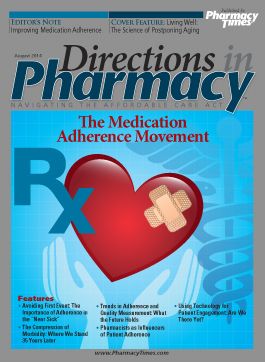Publication
Article
Pharmacy Practice in Focus: Oncology
Emerging Trends in Adherence and Quality Measurement: What the Future Holds
Author(s):
Adherence measurement can help patients achieve better outcomes.
Adherence measurement can help patients achieve better outcomes.
A focus on quality measurement—coupled with significant redesign in reimbursement and patient care—has become a dominant theme over the past 2 decades within the US health care system. Increased quality measurement has resulted in improved patient outcomes, as well as decreased spending in some specific disease areas. Every sector of health care, including pharmacy, has been impacted by this new approach to quality.
In the past, pharmacy reimbursement has centered on a fee-for-service system based on the number of prescriptions dispensed to patients. In the evolving system, pharmacy reimbursement will be increasingly linked to performance on a defined set of medication-based metrics. This includes both pay-for-performance systems and limited networks. The initial measures used to evaluate programs include adherence and medication safety metrics developed by the Pharmacy Quality Alliance (PQA).
Pharmacy Quality Alliance
After the rollout of the Medicare Part D program in 2006, then-Centers for Medicare & Medicaid Services (CMS) administrator Mark McClellan, MD, recognized the need to measure and evaluate the performance of Part D health plans as related to medication management. The PQA was born based on vision and need. The PQA is a nonprofit organization that strives to facilitate such improvements in health care quality through promotion of appropriate medication use, and the development of strategies for measuring and reporting performance information related to medications and medication management. Today, PQA represents more than 150 pharmacy stakeholders from a variety of fields—community pharmacy, pharmaceutical manufacturers, health plans, pharmacy benefit managers, academic universities, government agencies, long-term care facilities, health solution vendors, associations, and many more.
PQA originally created measures related to appropriate and safe medication use for inclusion in the evaluation of Medicare pharmacy plans. PQA had seen uptake of its measures in the Medicare Star Ratings, with 5 measures included and an additional 4 utilized as display measures. Over PQA’s 8-year history, the utilization of PQA measures has expanded to areas outside of Medicare as well. PQA continues to create measures not only for use at the health plan level, but also for use by community pharmacies, long-term care facilities, and integrated care teams.
How to Calculate Adherence
High adherence is considered to be a proportion of days covered (PDC) of >80% for most medication classes. One exception is antiretrovirals, where the target adherence goal is PDC >90%. PDC is 1 of 2 key measure calculations of adherence that are utilized in health care: the other is the medication possession ratio (MPR). MPR can be calculated through various methods to obtain a summation of the days’ supply of medication, which commonly results in an overestimation of a patient’s adherence. The lack of standardization in a definition only further complicates this issue. PDC is calculated according to fill dates and day supply, along with measuring for full persistence across the measurement period, not stopping after the last fill as MPR does. The utilization of PDC allows for a more accurate, conservative reflection of a patient’s adherence level. Because of its accuracy, consistent definition, conservative estimations, and extended application to multiple medications, PDC is considered by PQA to be the preferred method of adherence calculation.
Additionally, and equally as important, PDC is considered to be the most appropriate methodology for calculating adherence by a variety of entities, including the National Quality Forum (NQF), the Centers for Medicare & Medicaid Services (CMS), the National Committee for Quality Assurance, URAC, and the Center for Clinical Standards and Quality, for use in health insurance exchanges. PQA encourages all pharmacies to align their adherence calculation methods with national standards.
Why Measure Adherence?
Medication adherence has been identified as a $290-billion per annum problem in the United States. Several key PQA measures focus on adherence to medications, particularly chronic, high-prevalence disease states. The first measures created by PQA were PDC for antihypertensive agents, non-insulin diabetes medications, and statins. PQA also created additional measures focusing on high-cost medication treatment adherence: antiretroviral medications and non-warfarin oral anticoagulants.
Measurement of adherence is considered to be an intermediate outcome measure by CMS, meaning that these measures target a specific result that can help patients achieve an improved health outcome. These measures are triple-weighted inside the Medicare Stars rating program, indicating CMS’ recognition of the importance of appropriate medication use. For this reason, health plans focus on strategies to improve adherence. Plans are beginning to evaluate the performance of pharmacies on quality metrics and adopting strategies related to underperforming and high-performing pharmacies.
The ability of pharmacists to improve patient outcomes and overall patient health has been accentuated by the integration of quality metrics into pharmacy evaluation. The high level of attention this has received is due in large part to Medicare quality bonus payments (QBPs), which have resulted in an increased focus on medication use and safety measures because of the relative weighting and the importance of the adherence and medication safety measures’ impact on the QBP and overall Star rating. Medicare QBPs are bonuses provided to Medicare Advantage plans that receive a 4- or 5-star quality rating. Health plans and pharmacy benefit managers have begun altering their payment strategies to include performance-based payment mechanisms, determined by the pharmacy’s performance on quality metrics.
In October of 2013, Inland Empire Health Plan (IEHP) initiated a pay-for-performance program for network pharmacies in California, focusing pharmacist involvement in improving these health metrics. IEHP’s quality measurement system for pharmacies consisted of the CMS Part D Stars measures, while also integrating additional quality measures they identified as important to the specific population they serve. IEHP had identified asthma as a targeted disease state in their population and utilized 2 additional metrics focusing on proper treatment of asthma with controller and rescue medications. Program participation is optional for eligible pharmacies (eligibility determined by pharmacy location, prescription volume, and status in their pharmacy network), but eligible pharmacies receive a bonus payment based on the pharmacy’s performance and the number of IEHP prescriptions filled by the pharmacy.
IEHP’s program is not the only example of a health plan realigning incentive for their network pharmacies. An increasing number of health plans and PBMs are focusing on pharmacy quality measurement results, and are evaluating modifications to how pharmacies are included in programs and reimbursed in the future. These modifications include preferred pharmacy networks to include only pharmacies that provide the greatest quality on star metrics. Two additional practices considered by payers include bonuses and withholds. Bonuses can be included in pay-for-performance programs for meeting or exceeding specified quality goals. Withholds occur when payers hold back a portion of the payment depending on whether the pharmacy meets the desired quality metric goals. Public-facing performance report cards for pharmacies are also being considered for future use.
However, this modification is not only expected in Medicare plans, but also in other plans, possibly including Medicaid, commercial and exchange. Adherence metrics have been added to the Health Insurance Exchange Quality Ratings System beta test and will be used in the evaluation of exchange plans.
What the Future Holds for Pharmacy
The position of a pharmacist as the “most accessible health care professional” has facilitated the creation of pharmacy pay-for-performance (P4P) programs. Pharmacists are in an ideal position to intervene with patients pertaining to improved medication use. Pharmacists have demonstrated their ability to impact patient health through improved adherence, and meeting desired guideline-defined disease management goals. This is particularly noted in high-prevalence, high-burden chronic diseases such as hyperlipidemia, diabetes, and hypertension, key focuses of many performance measures.
The future is full of opportunities for pharmacists to deepen their contributions to patient care and work in concert with other providers to address common goals. With health plans becoming increasingly focused on achieving high performance on quality, pharmacists equipped with current quality knowledge will stand at a unique advantage. As experts in medication management, pharmacists are critical to the achievement of positive health care outcomes. These pharmacists will be ready to work in collaboration with other providers, patients, and health plans to optimize health care, and demonstrate the value of their services in achieving improved adherence and medication safety results.
Laura Cranston, RPh, serves as the executive director of the Pharmacy Quality Alliance (PQA, Inc). In this role, she oversees the development of medication use measures and works with organizations, including health plans, pharmacy benefit managers, community pharmacy organizations, employers, and others to encourage the uptake and implementation of meaningful medication use measures into the marketplace. Additionally, Laura serves as pharmacy’s representative on the National Priorities Partnership, an initiative convened by the National Quality Forum. She also serves on the Quality Alliance Steering Committee.
Prior to her current position, Laura served as the executive director for the Institute for the Advancement of Community Pharmacy. For over a decade, Laura served as the vice president of pharmacy affairs for the National Association of Chain Drug Stores.
Laura currently serves as chair of the dean’s advisory council of the St. John’s University College of Pharmacy and Health Sciences, the Washington DC Alumni President of the St. John’s University Chapter, the University of Notre Dame College of Pharmacy Board of Advisors, and she also serves on the St. John’s Board of Governors for the University.Laura is a pharmacy graduate of St. John’s University College of Pharmacy and Allied Health Professions in New York.Laurin Dixon, PharmD, serves as the 2013-14 Pharmacy Quality Alliance (PQA) Fellow. As the inaugural PQA Fellow, Laurin will be instrumental in shaping the PQA custom-tailored, 1-year, postgraduate training program. She will be working with issues related to appropriate medication management and use as well as managing PQA projects and research initiatives. Laurin will also participate in the PQA work group process to support quality metric design and use. Laurin joins PQA as a new Doctor of Pharmacy graduate from the University of Mississippi School of Pharmacy. Laurin has supplemented her formal education with pharmacy experience at Walgreens, including the honor of being selected to Walgreens’ Corporate Internship program.







